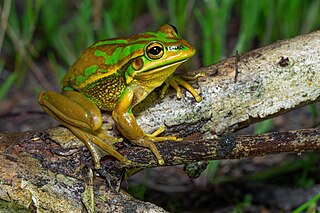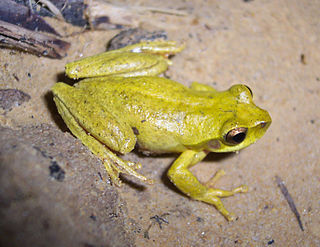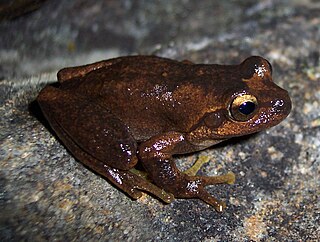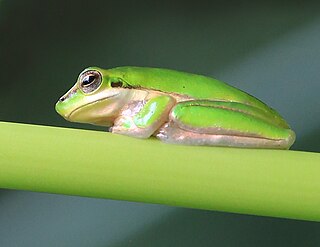
The green and golden bell frog, also named the green bell frog, green and golden swamp frog and green frog, is a species of ground-dwelling tree frog native to eastern Australia. Despite its classification and climbing abilities, it does not live in trees and spends almost all of its time close to ground level. It can reach up to 11 cm (4.5 in) in length, making it one of Australia's largest frogs.

The Australian green tree frog, also known as simply green tree frog in Australia, White's tree frog, or dumpy tree frog, is a species of tree frog native to Australia and New Guinea, with introduced populations in the United States and New Zealand, though the latter is believed to have died out. It is morphologically similar to some other members of its genus, particularly the magnificent tree frog (R. splendida) and the white-lipped tree frog (R. infrafrenata).

The Pacific tree frog, also known as the Pacific chorus frog, has a range spanning the Pacific Northwest, from Northern California, Oregon, and Washington to British Columbia in Canada and extreme southern Alaska. They live from sea level to more than 10,000 feet in many types of habitats, reproducing in aquatic settings. They occur in shades of greens or browns and can change colors over periods of hours and weeks.

The white-lipped tree frog is a species of frog in the subfamily Pelodryadinae. It is the world's largest tree frog and is found in Australia. Other common names include the New Guinea treefrog, giant tree frog, and Australian giant treefrog.

The leaf green tree frog is a species of stream-dwelling frog, native to eastern Australia from the Queensland/New South Wales border south to Sydney.

The revealed frog, whirring tree frog, or orange-thighed treefrog is a species of tree frog native to coastal eastern Australia.

The southern brown tree frog, also known as the brown tree frog, whistling tree frog, or Ewing's tree frog, is a species of tree frog native to Australia: most of southern Victoria, eastern South Australia, southern New South Wales from about Ulladulla—although this species is reported to occur further north—and throughout Tasmania including the Bass Strait Islands, in which state it is the most frequently encountered frog. It has been introduced to New Zealand, where it can be locally abundant.

The tusked frog is a species of ground-dwelling frog native to eastern Australia from Eungella National Park, Queensland south to Ourimbah, New South Wales. It is the only species in the genus Adelotus - adelotus meaning "unseen" and brevis meaning "short".

The mountain stream tree frog is a species of tree frog native to highland areas of NSW, Australia stretching from the Myall Lakes area, north to around Dorrigo National Park and west to Barrington Tops National Park.

Pearson's green tree frog, also known as the cascade tree frog, is a species of tree frog inhabiting rainforest creeks from north of Lismore, New South Wales, to Kenilworth, Queensland, with a disjunct population at Kroombit Tops Queensland, Australia.

The Pine Barrens tree frog is a species of New World tree frog. It is becoming rare due to habitat loss.

Littlejohn's tree frog, also called a heath frog or orange-bellied tree frog, is a species of tree frog native to eastern Australia from Wyong, New South Wales, to Buchan, Victoria.

The Booroolong frog is a species of stream-dwelling frog native to the Great Dividing Range in New South Wales, Australia. It is a member of the Hylidae, or the "tree frog" family. The Booroolong frog is classified by the IUCN as a Critically Endangered Species.

The northern dwarf tree frog is a small species of tree frog native to northern Australia, from the Kimberly region of Western Australia to Bowen, Queensland, and Aru Islands of Indonesia.

The green-thighed frog is a species of tree frog in the subfamily Pelodryadinae. Members of this species are medium-sized, ground-dwelling frogs, and are found in Australia.

The rough frog, also known as the woodland water-holding frog, warty water-holding frog, and red-backed cyclorana, is a species of treefrog native to northern New South Wales and south-eastern Queensland, Australia.

The common mist frog is a species of tree frog native to north-eastern Queensland, Australia. It is a medium-sized frog and a member of the Australian torrent treefrog group. The common mist frog is found in remote, mountainous areas, and near rocky, fast-flowing rainforest streams such as those in north-eastern Queensland, Australia. They are generally sedentary frogs, and remain in the stream environments that they are born into, preferring sections of the stream with riffles, many rocks, and overhanging vegetation.
"Litoria" castanea, also known as the yellow-spotted tree frog, New England swamp frog, tablelands bell frog, or yellow-spotted bell frog, is a species of frog in the subfamily Pelodryadinae. It is a critically endangered species of frog that is endemic to south-eastern Australia.

Davies' tree frog is a species of frog in the subfamily Pelodryadinae. It is endemic to Australia. Its natural habitats are subtropical or tropical dry forests, subtropical or tropical moist lowland forests, subtropical or tropical dry shrubland, and rivers. It is currently threatened by habitat loss.

The New England tree frog or glandular tree frog is a species of frog in the subfamily Pelodryadinae, endemic to Australia. Its natural habitats are temperate forests, subtropical or tropical moist lowland forests, subtropical or tropical moist montane forests, temperate shrubland, rivers, and pastureland. It is threatened by habitat loss.




















